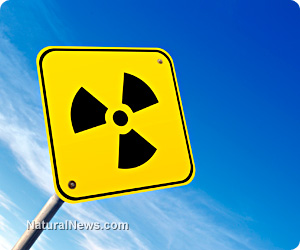
Study: Fukushima radiation fallout has devastated health of US babies on West Coast and in other areas
Monday, April 15, 2013 by: Jonathan Benson, staff writer
Tags: Fukushima, radiation, hypothyroidism
- TAKE IT DOWN Act advances in Congress amid free speech concerns
- Gardening tips: 15 Simple tricks to double your garden’s yield this season
- Survival 101: Dangerous places to avoid when disaster strikes
- Nature’s arsenal: How plant compounds power military survival and healthcare in crisis
- Kawasaki unveils rideable ROBOT HORSE powered by hydrogen
- DOJ and ATF kill Biden’s “Zero Tolerance” firearms dealer policy
- Amazon's Kuiper satellite launch delay highlights uphill battle against Musk's Starlink
- Hospital staffers sound alarm after 10 nurses were diagnosed with BRAIN TUMORS
- Barley: A nutrient-dense ancient grain with modern benefits
- Criminal referral requests filed against Fauci and top COVID officials in seven states
- “Prepare Tribe: Prepare, Protect, Provide” on BrightU: How to build a disaster-proof shelter in the middle of nowhere
- New studies ignite debate: Fluoride linked to autism and ADHD, prompting calls for policy reassessment
- Germany prepares students for war amid growing security concerns
- Rafael Medoff explores the role of Jabotinsky in the rise of Revisionist Zionism in “Militant Zionism in America”
- Sovereign debt paradox: U.S.-China mutual holdings fuel geopolitical tensions
- Yoga and autism: A science-backed look at how a simple practice is transforming behavior and movement in children with ASD
- POLL: U.S. support for Israel drops to lowest level in decades amid Gaza War
- Widespread social and economic unrest: Steve Quayle issues urgent financial warning of imminent asset collapse in new interview with Mike Adams
- Tulsi Gabbard leads charge against the Biden regime’s global censorship of the 'Disinformation Dozen'
- Fauci is back in the limelight, and he’s busy promoting a future COVID or FLU pandemic
- Aerosolized bioweapons? Strange “diploid biomasses” falling out of the sky in Florida captured under the microscope
- Analysis: The coming economic collapse, a mass uprising and Trump's three secret weapons to halt the growing revolt
- Widespread social and economic unrest: Steve Quayle issues urgent financial warning of imminent asset collapse in new interview with Mike Adams
- Kiss Your Genetic Privacy Good-Bye! 23andMe Gets Green Light to Sell Your Intimate Genetic Details to Anyone They Want
- Tulsi Gabbard takes aim at censorship: Justice for the ‘Disinformation Dozen’
- Mike Adams releases country western hit single: Goin’ Back in Time is Comin’ Home
- U.S. lawmakers investigate Meta over alleged China collaboration
- CLOT SHOT PLANDEMIC UNFOLDING: Fibrous, rubbery clots caused by covid injections have prion-like seeding activity
- Chemtrails unveiled: How the CIA and Big Business are manipulating the weather for profit
- How Israeli military-connected corporations are secretly controlling your online privacy
- European Court of Justice: Healthcare professionals who promoted or administered COVID-19 vaccines are CRIMINALLY LIABLE for any harm caused
- DEATH by VACCINE or face PRISON time: Canadian Freedom Convoy leaders CONVICTED for protesting forced vaccination during the Covid Plandemic
- Defunding DEADLY mRNA jabs: Government funding for mRNA technology being scrutinized and sidelined until proven "safe and effective" for real
- Federal employees whine over DOGE's new directive requiring them to do a 5-point summary of weekly accomplishments
- U.S. approves new Russian ambassador as diplomatic thaw continues
- Curcumin’s ancient healing power supercharges muscle recovery, and its effects are compounded with anti-inflammatory foods and supplements
- Newly released JFK files reveal Pentagon's role in creating Lyme disease and covid in the same lab
- Analysis: The coming economic collapse, a mass uprising and Trump's three secret weapons to halt the growing revolt
- Mike Adams releases country western hit single: Goin’ Back in Time is Comin’ Home
- Aerosolized bioweapons? Strange “diploid biomasses” falling out of the sky in Florida captured under the microscope
- Kiss Your Genetic Privacy Good-Bye! 23andMe Gets Green Light to Sell Your Intimate Genetic Details to Anyone They Want
- Dr. Mike Yeadon releases 15-minute testimony - WATCH - about genocidal intent of COVID “vaccines”
- Trump reverses course on Gaza plan, says “nobody is expelling Palestinians”
- MEDICAL BOMBSHELL: FDA admits Covid mRNA 'Vaccines' CAUSE CANCER
- European Court of Justice: Healthcare professionals who promoted or administered COVID-19 vaccines are CRIMINALLY LIABLE for any harm caused
- The Health Ranger releases “Vaccine Zombie” song and music video, using AI-animated zombies for the music video
- 5 Simple steps to boost your brainpower: How to strengthen executive function in a distracted world
- A lack of integrity in Academia: Harvard professor found GUILTY of fraudulent research to promote CRT theory
- Federal employees whine over DOGE's new directive requiring them to do a 5-point summary of weekly accomplishments
- EPA advisor admits the agency is funneling billions to climate groups ahead of Trump’s return to White House
- California's social media censorship law struck down: A victory for free speech or a threat to online safety?
- Space war brewing? Russia threatens to destroy Starlink satellites
- Survival 101: Effective EMF blocking techniques
- Rep. Nancy Mace introduces bill to ban biological males from female facilities on federal property
- Red Cross issues warning to stop blood plasma donations from vaccinated people
- Scientists confirm: GENIUS brain function can be spontaneously unleashed in humans without any apparent cause
- EPA advisor admits the agency is funneling billions to climate groups ahead of Trump’s return to White House
- HYSSOP: What research reveals about the health benefits of this ancient holy herb
- Two containers with completed ballots fall out of truck in Florida
- Newly released JFK files reveal Pentagon's role in creating Lyme disease and covid in the same lab
- Global leaders unite to clamp down on “misinformation” with UN-backed Cascais Declaration
- BREAKING: 2025 NDAA authorizes mandatory military draft of WOMEN across America… as Pentagon pursues global NUCLEAR war with both Russia and China at the same time
- Michael Yon warns of a ZIONIST TAKEOVER in Trump’s second administration
- Ozempic and Wegovy weight loss drugs are injectable LIZARD VENOM PEPTIDES that may unleash a devastating wave of organ failure… side effects align with symptoms of SNAKE BITES
- The Health Ranger releases “Vaccine Zombie” song and music video, using AI-animated zombies for the music video
- Mike Adams releases country western hit single: Goin’ Back in Time is Comin’ Home
- BOMBSHELL: DNA testing kits are a SCAM to develop ethnic-specific bioweapons
- Israeli soldiers accused of even more torture and abuse in the West Bank
- These 13 countries just signed an agreement to engineer a global FAMINE by destroying food supply
- NASA admits that climate change occurs because of changes in Earth’s solar orbit, and NOT because of SUVs and fossil fuels
- Fully vaccinated about to see “tsunami” of illness and death, warns virologist
- RFK Jr. clears key hurdle: Sen. Susan Collins backs controversial HHS nominee, signaling a new era for health policy
Conducted by a duo of scientists from the Radiation and Public Health Project, a non-profit education and scientific organization that seeks to understand the relationship between nuclear radiation exposure and public health, the research evaluated average rates of hypothyroidism both before and after the Fukushima disaster. In their findings, Joseph J. Mangano and Janette D. Sherman reported that, compared to one year earlier, babies born between one week and 16 weeks after the nuclear meltdowns in Alaska, California, Hawaii, Oregon, and Washington were 28 percent more likely to suffer from congenital hypothyroidism.
2,110 percent increase in iodine-131 on US West Coast following Fukushima linked to hypothyroidism
Each of these states and the Pacific Ocean, according to the study, experiences significantly elevated levels of radioactive iodine-131 (I-131), as well as various other radioactive isotopes, in the days and weeks following the March 11, 2011, disaster. Based on the data, the 2,110 percent increase in detectable I-131 all along the U.S. West Coast following the disaster appears to be directly correlated with the higher-than-average rates of congenital hypothyroidism."After entering our bodies, radioactive iodine gathers in our thyroids," explains John Upton, writing for Grist.com, about how radioactive isotopes interfere with proper thyroid function. "Thyroids are glands that release hormones that control how we grow. In babies, including those not yet born, such radiation can stunt the development of body and brain. The condition is known as congenital hypothyroidism."
You can view an abstract of the new study here:
http://www.scirp.org/journal/PaperInformation.aspx?PaperID=28599
You can also download or view a PDF file of the complete study here:
http://www.scirp.org/journal/PaperDownload.aspx?paperID=28599
A similar uptick in congenital hypothyroidism, which is fully treatable if detected early, was also observed in young children following the historic meltdown of the Chernobyl nuclear reactor back in 1986. Because of this, researchers are even more convinced that Fukushima is responsible for the now-occurring uptick, which is only just now beginning to be realized.
"Congenital hypothyroidism can be used as one measure to assess any potential changes in U.S. fetal and infant health status after Fukushima because official data was available relatively promptly," wrote the authors in their report. "However, health departments will soon have available for other 2010 and 2011 indicators of fetal/infant health, including fetal deaths, premature births, low birth weights, neonatal deaths, infant deaths, and birth defects."
For the latest developments related to the Fukushima disaster, be sure to check out the Fukushima Diary blog:
http://fukushima-diary.com/
Sources for this article include:
http://www.scirp.org/journal/PaperInformation.aspx?PaperID=28599
http://www.scirp.org/journal/PaperDownload.aspx?paperID=28599
http://grist.org
Fukushima at FETCH.news
Get independent news alerts on natural cures, food lab tests, cannabis medicine, science, robotics, drones, privacy and more.
Take Action: Support Natural News by linking to this article from your website
Permalink to this article:
Embed article link: (copy HTML code below):
Reprinting this article:
Non-commercial use OK, cite NaturalNews.com with clickable link.
Follow Natural News on Facebook, Twitter, Google Plus, and Pinterest
Science News & Studies
Medicine News and Information
Food News & Studies
Health News & Studies
Herbs News & Information
Pollution News & Studies
Cancer News & Studies
Climate News & Studies
Survival News & Information
Gear News & Information
News covering technology, stocks, hackers, and more



"Big Tech and mainstream media are constantly trying to silence the independent voices that dare to bring you the truth about toxic food ingredients, dangerous medications and the failed, fraudulent science of the profit-driven medical establishment.
Email is one of the best ways to make sure you stay informed, without the censorship of the tech giants (Google, Apple, Facebook, Twitter, YouTube, etc.). Stay informed and you'll even likely learn information that may help save your own life."
–The Health Ranger, Mike Adams













































